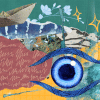William Blake: Pioneering psychoethnography in art and poetry

William Blake, an English poet, painter, and printmaker, stands as a seminal figure in the realms of both art and literature. His works are often characterised by their mysticism, symbolism, and unconventional themes, transcending the boundaries of his time and resonating with audiences across generations. Beyond his contributions to poetry and art, Blake's work also exhibits a profound understanding of human psychology and cultural dynamics, laying the groundwork for what can be termed as "psychoethnography". This essay aims to explore the significance of William Blake as a pioneer of this field by examining his artistic and poetic endeavours in the context of contriving the human psyche and cultural narratives.
Psychoethnography, a term that combines elements of psychology and ethnography, refers to the study of human behaviour, beliefs, and cultural practices through the lens of individual and collective psyche. It involves delving into the psychological underpinnings of cultural phenomena, aiming to uncover the intricate interplay between the human psyche and societal constructs. In this regard, psychoethnography seeks to illuminate the depths of human consciousness and cultural symbolism, offering insights into the complexities of human existence.
Blake was a walker and a wanderer, whose poems described the reality of 18th century street life or as he stated: "My streets are my Ideas of Imagination".
In his poem, "London", published as part of his collection titled Songs of Experience (1794) he mentions:
"I wander thro' each charter'd street,
Near where the charter'd Thames does flow.
And mark in every face I meet
Marks of weakness, marks of woe."
In addition to his exploration of the individual psyche in the context of everyday society, Blake's work also encompasses a broader critique of cultural norms and societal structures. Through his keen observation and symbolic analysis, the poet unveils the hidden dynamics of power, oppression, and social injustice. His poem "London", for instance, serves as a scathing indictment of the dehumanising effects of urbanisation and industrialisation, laying bare the psychological toll of societal decay.
Blake's works are replete with themes that delve into the depths of the human psyche connecting to societal reality. His poetry, infused with rich symbolism and allegory, often serves as a mirror reflecting the intricacies of the human mind. In poems such as "The Tyger" (1794) and "The Chimney Sweeper" (1789), Blake grapples with existential questions, exploring themes of innocence, experience, and the duality of human nature. Through his vivid imagery and lyrical prowess, Blake invites readers to embark on a journey into the labyrinth of the psyche, confronting both its light and shadow aspects.
Furthermore, Blake's artistic endeavours, particularly his illuminated books, such as Songs of Innocence and of Experience (1789) and The Marriage of Heaven and Hell (1790), serve as visual manifestations of his psychoethnographic exploration. By intertwining text and imagery, Blake creates multidimensional narratives that transcend mere representation, offering glimpses into the collective unconscious. His symbolic use of archetypal figures, biblical motifs, and mystical imagery serves to unravel the layers of human consciousness, revealing the underlying currents that shape individual and societal behaviour.
Moreover, Blake's reinterpretation of biblical narratives and mythological motifs exemplifies his psychoethnographic approach to cultural analysis. In works such as The Book of Urizen (1794) and Milton (1810), Blake subverts traditional religious narratives, offering alternative perspectives that challenge established dogmas and moral frameworks. By deconstructing cultural symbols and reimagining mythic archetypes, Blake invites readers to question the underlying psychological and cultural forces that shape collective consciousness.
The legacy and influence of William Blake's pioneering efforts in psychoethnography have left an indelible mark on the fields of art, literature, and psychology. His innovative approach to exploring the human psyche and cultural dynamics continues to inspire scholars, artists, and thinkers alike. From the surrealists to the existentialists, Blake's influence reverberates through various intellectual movements, underscoring the enduring relevance of his psychoethnographic insights.
In summary, William Blake emerges as a trailblazer in the realm of psychoethnography, demonstrating a profound understanding of the human psyche and cultural symbolism. Through his poetry and art, Blake invites readers to embark on a journey of introspection and cultural critique, unravelling the intricate tapestry of human consciousness. His legacy as a psychoethnographer transcends temporal boundaries, offering timeless insights into the complexities of the human condition.
As we continue to grapple with questions of identity, meaning, and societal change, Blake's visionary oeuvre serves as a guiding light, illuminating the path towards a deeper understanding of ourselves and the world we inhabit.
Dr S. M. Akramul Kabir is a Research Fellow at the University of Otago, New Zealand. His areas of research include language education, teacher education, educational psychology, and ICT in education.

 For all latest news, follow The Daily Star's Google News channel.
For all latest news, follow The Daily Star's Google News channel. 








Comments